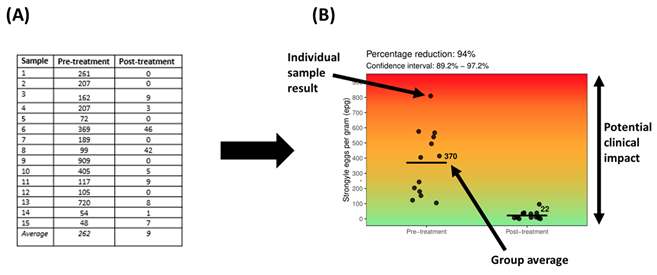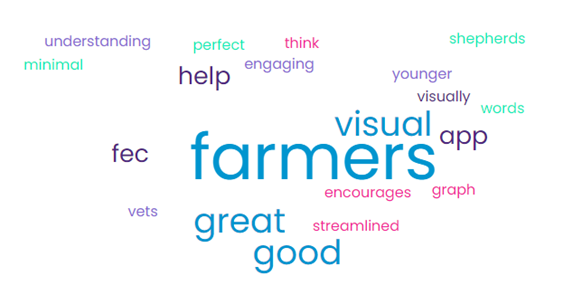Roundworms are typically controlled using anthelmintics, however, resistance to one or more of the 5 available drug classes is common on UK farms. Targeting our use of anthelmintics, by treating animals only when they require it, could slow the development of resistance and reduce chemical usage on farm. Faecal egg counts allow farmers to monitor whether animals require treatment, when to administer it and to check whether the treatment was effective. Fresh faeces can be collected from the ground for testing, this can be done individually, or samples from 10-15 animals can be combined and a ‘pooled’ test conducted.
Although the test itself is simple, knowing what results mean can be difficult. For example, treatment thresholds vary depending on whether samples have been tested to check how well a treatment has worked (efficacy testing) or been used to monitor infection within the flock. Testing is available through diagnostic labs, independent veterinary surgeries and is increasingly performed independently by farmers at home and we know from previous farmer-facing projects that engagement in livestock health amongst vets is variable. This means that farmers sometimes receive results without context or interpretation because test providers don’t have a framework to present the results to their clients. Although information on the practical meaning of results is available, extracting the information applicable to individual situations can be challenging.
Therefore, to simplify the interpretation of faecal egg count results and assist with decision-making, we have developed the “FEC Check” tool to visually demonstrate the clinical implication of test results. The tool combats variation in reporting amongst providers, ensuring that all farmers have access to the information they need to translate test results into informed management decisions.
Users input faecal egg count results (Figure 1A) and the app visualises the results on a graph (Figure 1B) with a colour gradient which represents the clinical impact of the result i.e. green to indicate low-level infection, not requiring treatment, and red indicating that treatment is likely needed. The design has also been adapted for colourblind users with the red appearing darker than the green.

Figure 1. Prototype results template was developed and initially tested within a current Biotechnology and Biological Sciences Research Council (BBSRC) PhD project. Information was translated from a typical results table (A) into a visual graphic (B) for ease of interpretation by farmers.
Sheep farmers, vets and livestock health advisors were invited to test the prototype tool and offer opinions during four focus groups (Figure 2).

Figure 2: Focus group meetings in which sheep farmers, vets and animal health advisors tested the prototype app and provided feedback.
Attendees gave positive feedback about the tool, summarised within the word cloud (Figure 3), and all stakeholder groups agreed that it would be useful for the industry.

Figure 3: word cloud summarising who the app could be useful for and what participants thought of the prototype app - collected from sheep farmers, vets and animal health advisors attending the focus groups.
In general participants enjoyed the graphical representation of results, describing it as “visually great” and “perfect for farmers and shepherds”. One participant also commented that this tool could “encourage people to think about what they are doing”, which supports the aim of promoting evidence-based treatment decisions.
Good resources on sustainable roundworm control have been developed by us and several other organisations, but finding the applicable information can still be challenging. To address this, information pages and links to trusted and relevant resources were provided within the app:
- “How to collect a good faecal sample for testing” was a particular favourite of the advisors and vets attending the focus groups who highlighted the quality/freshness of samples as a key factor in the accuracy and usability of egg count results.
- How faecal egg counts can be used in different ways to build a picture of the roundworm population on a farm and understanding the typical roundworm lifecycle were included to help farmers visualise what the results are telling them. Egg counts relate to the number of adult, egg-laying roundworms within the animal (these worms take ~21 days to mature from the larvae ingested from pasture) therefore the egg count can tell you about the parasite challenge experienced by the sheep 3 weeks prior to sampling. This knowledge could allow farmers to build a picture of the roundworm population on their farm to inform management and treatment decisions for the sustainable control of roundworms in sheep.
Overall, and within this Innovative Knowledge Exchange award, we have created an online tool and gathered opinions on what the sheep industry would find useful for the future. Three common themes were identified within the focus groups:
- the wish to view faecal egg count data longitudinally to highlight trends,
- regional alerts when several local farms log a rise in egg counts and
- the ability to share data with vets and advisors.
Currently useful information is being lost within the reporting system. Faecal egg count data is reported and used to make local treatment/management decisions, but it is often not stored. Over time, this information builds a picture of the roundworm population on farm, which fields are more heavily contaminated and which anthelmintics have worked well at which times of year. Sustainable roundworm control can be achieved if all of this information is considered together, and management/treatment decisions are taken as a result of the best and most complete available evidence. Further development of a tool such as FEC Check could address these issues, creating a valuable resource to aid future decision-making.
Lynsey Melville; MRI
Eilidh Geddes; MRI
Fiona Kenyon; MRI
Kate Lamont; SRUC
Andrew Duncan; SRUC
Acknowledgements
Designing and creating FEC Check has been a great experience and we would like to thank the various funding bodies and industry stakeholders who have made it possible. The concept was first development by Eilidh Geddes within her EastBio Biotechnology and Biological Sciences Research Council studentship project. Support from SEFARI Gateway allowed us to build this concept into a prototype and co-design the app with stakeholders. Further funding was attained from the Veterinary Medicines Directorate to translate the app into a format which can be hosted on websites and viewed on mobile devices.
Key to the success of this project has been the support from industry stakeholders. We would like to thank the farmers, vets and advisors who willingly gave up their time to test the prototypes and provide valuable feedback. Their input allowed us to adapt our ideas to fit the requirements of the sheep industry, hopefully creating a tool which will be widely used.
